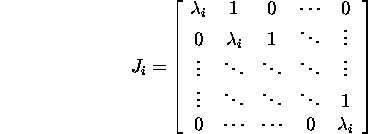Proposition
2.8.1 (Cayley-Hamilton theorem). If ![]() and
and
![]()
then p(A)=0, i.e., the matrix A satisfies its
characteristic equation.
Proof. According to proposition
2.6.7, there exists a regular matrix ![]() such that
such that
![]()
where

is an upper bidiagonal ![]() matrix
(Jordan block) that has
on its main diagonal the eigenvalue
matrix
(Jordan block) that has
on its main diagonal the eigenvalue
![]() of the matrix A( at least mi-mutiple eigenvalue
of the matrix A since to this eigenvalue may correspond some more
Jordan's blocks) and
of the matrix A( at least mi-mutiple eigenvalue
of the matrix A since to this eigenvalue may correspond some more
Jordan's blocks) and ![]() Since
Since ![]()
![]() then
then ![]() and
and ![]() )mi=0. If
)mi=0. If ![]() is the characteristic polynomial of
the matrix A and the zeros of this polynomial are
is the characteristic polynomial of
the matrix A and the zeros of this polynomial are ![]() , then
, then
![]()
and
![]()
We show that p(J)=0. Let the matrix J have the block
form:

We obtain that
![]()







From the relation X-1AX=J it follows that
A=XJX-1. We complete the proof with
![]()
![]()
![]()
Example 2.8.1. Verify the assertion of the Cayley-Hamilton theorem for the matrix
 .
.
We construct the characteristic polynomial
![]()
and find

![]()
Exercise 2.8.1.* Let

Compute A2, and using the Cayley-Hamilton
theorem, find the matrix
![]()
Definition 2.8.1.
A polynomial ![]() is called a nullifying polynomial of the matrix
is called a nullifying polynomial of the matrix ![]() if q(A)=0.
if q(A)=0.
The characteristic polynomial
of the matrix ![]() is a nullifying polynomial of this matrix (by the Cayley-Hamilton
theorem).
is a nullifying polynomial of this matrix (by the Cayley-Hamilton
theorem).
Definition 2.8.2. The
nullifying polynomial of the matrix
![]() of the lowest degree is called the minimal polynomial of
the matrix A.
of the lowest degree is called the minimal polynomial of
the matrix A.
Exercise 2.8.1. Verify that the characteristic
polynomial of matrix ![]() is divisible by the minimal polynomial
of the matrix A without remainder.
is divisible by the minimal polynomial
of the matrix A without remainder.
Proposition 2.8.2.
Let ![]() and
and ![]() be the characteristic polynomial
and the minimal polynomial of the matrix
A, respectively. Let the greatest common divisor of the matrix
be the characteristic polynomial
and the minimal polynomial of the matrix
A, respectively. Let the greatest common divisor of the matrix ![]()
![]() that is, the matrix of algebraic complements of the elements of the matrix
that is, the matrix of algebraic complements of the elements of the matrix
![]() -A) , be
-A) , be ![]() .
Then,
.
Then,
![]()
Proof. See Lankaster (1982, p. 123-124).
Example 2.8.2. Find the characteristic
polynomial and the minimal polynomial
of the matrix D=diag(a,a,b,b).
First we find that
![]()


and the greatest common divisor of the elements of the matrix ![]()
![]() is
is ![]() By the assertion of proposition 2.8.2
By the assertion of proposition 2.8.2
![]() Let us check
Let us check
![]()

Indeed, ![]() is the nullifying polynomial. It is
easy to verify that no polynomial of first degree can nullify the matrix
A. Thus,
is the nullifying polynomial. It is
easy to verify that no polynomial of first degree can nullify the matrix
A. Thus, ![]() is the minimal polynomial of the matrix
A.
is the minimal polynomial of the matrix
A.
Example 2.8.3. Find the characteristic
and the minimal polynomials of the matrices

First we find the characteristic polynomials
![]()

and

Next we find the minimal polynomials:
![]()


![]()
and
![]()

![]()